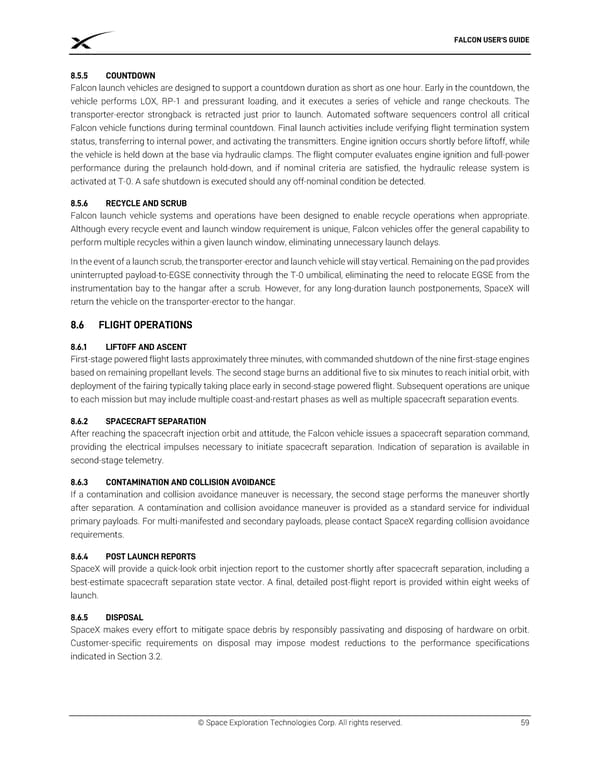FALCON USER’S GUIDE 8.5.5 COUNTDOWN Falcon launch vehicles are designed to support a countdown duration as short as one hour. Early in the countdown, the vehicle performs LOX, RP-1 and pressurant loading, and it executes a series of vehicle and range checkouts. The transporter-erector strongback is retracted just prior to launch. Automated software sequencers control all critical Falcon vehicle functions during terminal countdown. Final launch activities include verifying flight termination system status, transferring to internal power, and activating the transmitters. Engine ignition occurs shortly before liftoff, while the vehicle is held down at the base via hydraulic clamps. The flight computer evaluates engine ignition and full-power performance during the prelaunch hold-down, and if nominal criteria are satisfied, the hydraulic release system is activated at T-0. A safe shutdown is executed should any off-nominal condition be detected. 8.5.6 RECYCLE AND SCRUB Falcon launch vehicle systems and operations have been designed to enable recycle operations when appropriate. Although every recycle event and launch window requirement is unique, Falcon vehicles offer the general capability to perform multiple recycles within a given launch window, eliminating unnecessary launch delays. In the event of a launch scrub, the transporter-erector and launch vehicle will stay vertical. Remaining on the pad provides uninterrupted payload-to-EGSE connectivity through the T-0 umbilical, eliminating the need to relocate EGSE from the instrumentation bay to the hangar after a scrub. However, for any long-duration launch postponements, SpaceX will return the vehicle on the transporter-erector to the hangar. FLIGHT OPERATIONS 8.6.1 LIFTOFF AND ASCENT First-stage powered flight lasts approximately three minutes, with commanded shutdown of the nine first-stage engines based on remaining propellant levels. The second stage burns an additional five to six minutes to reach initial orbit, with deployment of the fairing typically taking place early in second-stage powered flight. Subsequent operations are unique to each mission but may include multiple coast-and-restart phases as well as multiple spacecraft separation events. 8.6.2 SPACECRAFT SEPARATION After reaching the spacecraft injection orbit and attitude, the Falcon vehicle issues a spacecraft separation command, providing the electrical impulses necessary to initiate spacecraft separation. Indication of separation is available in second-stage telemetry. 8.6.3 CONTAMINATION AND COLLISION AVOIDANCE If a contamination and collision avoidance maneuver is necessary, the second stage performs the maneuver shortly after separation. A contamination and collision avoidance maneuver is provided as a standard service for individual primary payloads. For multi-manifested and secondary payloads, please contact SpaceX regarding collision avoidance requirements. 8.6.4 POST LAUNCH REPORTS SpaceX will provide a quick-look orbit injection report to the customer shortly after spacecraft separation, including a best-estimate spacecraft separation state vector. A final, detailed post-flight report is provided within eight weeks of launch. 8.6.5 DISPOSAL SpaceX makes every effort to mitigate space debris by responsibly passivating and disposing of hardware on orbit. Customer-specific requirements on disposal may impose modest reductions to the performance specifications indicated in Section 3.2. © Space Exploration Technologies Corp. All rights reserved. 59
 SPACEX FALCON USER’S GUIDE Page 62 Page 64
SPACEX FALCON USER’S GUIDE Page 62 Page 64